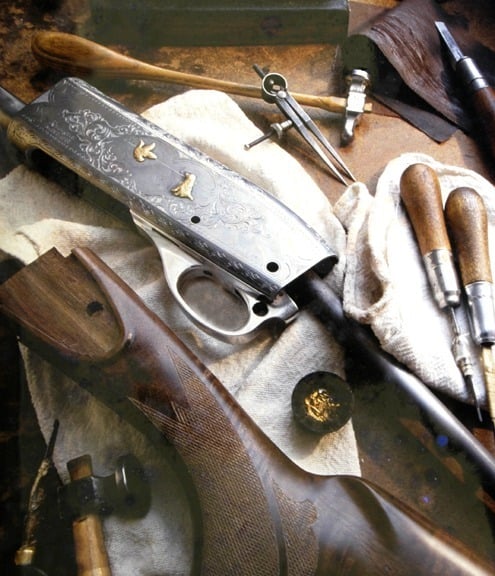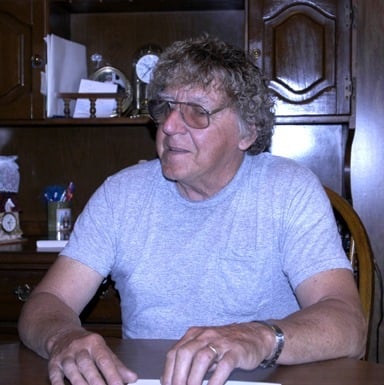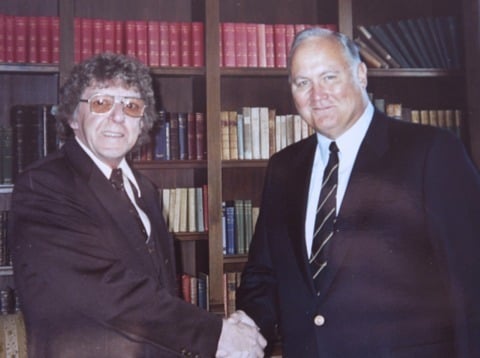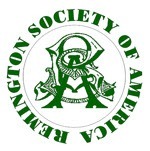
| RSA: | Leo, finally we meet. Our initial research led us into thinking you only did “D-Grade” scroll engraving, but your talents were greatly underestimated. An RSA member recently purchased a very nice Model 760 “F grade” with gold inlays signed by you. We would like to introduce you and your work in the Remington Custom Shop to the RSA membership. Would you begin by telling us where you were born and raised? |
|

|
| RSA: |
How did you get into engraving? |
| Leo: |
In 1967 I heard that they were looking for an engraver. I was interested in engraving, but had never done it before. At my interview Art Kerr asked me to bring in some of my art work, so I showed it to him and a couple of weeks later I was told I could have the job. |
| RSA: |
Did you have any special training in engraving before you were hired? |
| Leo: |
No, I enjoyed art and drawing in high school. I learned all my engraving on the job at Remington. |
|

|
| Leo: |
It was Bob Runge who was doing production engraving at the time. He is the one who taught me. I apprenticed under Runge. It took me a year or so before I was allowed to do my very first full engraving job. Bob also taught me about sharpening my tools. Each engraver sharpens differently. By the way I’m the only left handed engraver around. |
| RSA: |
You did both scroll and game scenes? |
| Leo: |
Once I started a gun, it was my gun and I finished it. I did whatever they wanted put on it, such as the breed of dogs and birds. In the case of the Model 760 it was big game in gold. “F-Grade” gold took me a while to learn. I didn’t get on gold right away, Bob Runge usually took care of that. After a while I got into it as Bob taught me. Gold work is tricky, and we used to undercut a scene and pound gold wire in. Then the gold was blended to shape. Later we cut the figure out of gold, silver soldered it in and then shaped it. |
| RSA: |
Were there any other engravers working for Remington at the time? |
| Leo: |
Carl Ennis was in another department – Research – and was involved in engraving special projects. He might have done a few production guns. Jack Caswell also engraved guns. He was an excellent engraver. When I went over to the checkering, we just could not keep up with the engraving. They hired Jack as he had worked as an engraver at Remington for a couple of years. He went to a salesman‘s job, then they called him back to engrave. When I first went down I started next to Bob, but when the lady checkerer passed away I went over to checkering. They hired Jack, and put him next to Bob. Jack didn’t need to be taught, he knew how to do it. They worked over there and I was doing most of the checkering. Jack did the complete job from start to finish. He did gold work, too. I’m not sure how he signed his work – JC or C |
|

|
| Leo: |
We had an engraving opening in the spring of 1979 and a number of plant workers applied. Don was selected and came on board as an apprentice to Bob Runge. Bob retired the end of December 1979. Later Jack Caswell retired. They then moved Don and I to a different area of the shop – first floor on Hoefler – the “Hole”. In 1995 we moved to the new Custom Shop. |
| RSA: | How did you get started in checkering? |
| Leo: |
When I came down in 1967 Edna Hinerick was doing the checkering. She passed away and I fell into the job. They wanted me to learn that, too. Runge had checkered for many years and taught me how to checker. For awhile I went back and forth – checkering, then engraving, then checkering, then engraving. Wherever I was needed. . Once they hired Jim Thompson to checker I went back to engraving. |

|
|
| Leo: |
Bob was like that. He wrote down everything. I began a log when I started – a little notebook – just because Bob taught me. After a while I got away from keeping one. It was a good idea, Bob wrote down everything including the hours it took to engrave a gun and did ink impressions. I also did ink impressions early on – they were messy and not much detail. Later I made smoke impressions using candle smoke and clear tape. |
| RSA: |
We know that each engraver has his own style. Can you describe your style? |
| Leo: |
Bob started out with Parker Bros. and was into English scroll. He would work some of that in. I started with Remington scroll, just what Bob taught me. Runge used wide borders, especially on rifles and I followed his style. On shotguns we usually used a narrow thin line border. Each engraver has a different style of scroll and I can tell who did it by the scroll work. Special guns did get English scroll. A customer could request special scenes on “F-Grade” work. A Model 700 bolt action rifle would get a big game scene on the floor plate while the receiver was mostly scroll with a small scene worked in. |
| RSA: |
Do you have any estimate of the number of guns you engraved at Remington? |
| Leo: |
No, don’t have any idea. It was a bunch. |
| RSA: |
One article mentions that you could engrave while chatting and that you might have been the fastest and most prolific engraver in the shop at the time. Your output was more than the other two engravers combined. Is that true? |
| Leo: |
Yes, I could talk while engraving, it did not bother me. I like to meet people. Others like Don prefer silence so they can concentrate. I was fast both in engraving and checkering and the work was decent looking. The bosses never set hours for a job but usually it takes 10 hours for “D-Grade”, 40 hours for “F-Grade” and 80 hours for a “F-Grade with gold” scenes. My times were faster than that. |
| RSA: |
Are there any |
| Leo: |
One customer had his favorite dog, a Labrador, die and he wanted him in gold on a shotgun. He sent up a bunch of pictures which I scaled down. It was a water scene with the Lab in gold looking at a pair of gold ducks, no hunter. He was very pleased and sent a nice letter that made me feel good. |
| RSA: |
When did you retire and what are you doing now? |
| Leo: |
I retired in 1997. Thereafter, I worked after hours with Bob Runge at Del Grego’s. I did most of the checkering there. They did a number of upgrades to Parker shotguns with new wood and I checkered most of the stocks. I have all of the patterns. Later after Bob had stopped engraving for Del Grego I would do some recutting and new engraving. I worked for Del Grego until I received Social Security then I fully retired. I also did some work for three other gunsmiths. I did a bunch of guns. |
| RSA: |
Your work has given great satisfaction to many owners. Do you have a Leo Bala engraved firearm and are there any future engravers in the family? |
| Leo: |
I enjoyed my job and going to work each day. I’m retired, but still like to look at engraved arms. I have a couple of guns I’ve started engraving. Here is a Model 1100 receiver polished with scroll work and a setter in the center panel. I have also started a Model 870 with geese flying and woodcock. When I have time I do a little more. The background will be matted. Don’t know what I’ll do with them when finished. |
| RSA: |
Thanks, Leo, our readers will enjoy learning more about you and your passion for engraving Remingtons. |
 Leo Bala and Jim Thompson work on high grade wood stocks in Remington’s Cusom Shot, circa ealy 1970’s Remington Archives photograph collection |
| On-line Search/Sort Journal Index |
On-line Journal Articles New Journals have links to
|
